.
[Image: 5/9/22, Victory Parade in Russia, UK Telegraph video. “Victory Day marks Germany’s surrender to the Soviet Union in 1945. It became the end of the Great Patriotic War for the USSR, which lost about 25 million citizens in the four years of fighting.”]
May 9, 2022, “Ukraine–Putin On Why The War Started, Failed Attempts On Snake Island, Other Issues,” Moon of Alabama
“Updates below (17:15 UTC)”
“It is Victory Day. As Ernest Hemingway said [additional source]:
“Anyone who loves freedom owes such a debt to the Red Army that it can never be repaid.”
The most important part of Vladimir Putin’s speech to the Victory Parade on the Red Square is the narrative that explains how the current war in Ukraine began. Putin is correct in seeing this as a NATO proxy war against Russia:
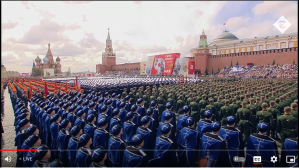 [Image: 5/9/22, Victory Parade in Russia, UK Telegraph video]
[Image: 5/9/22, Victory Parade in Russia, UK Telegraph video]
“[D]espite all controversies in international relations, Russia has always advocated the establishment of an equal and indivisible security system which is critically needed for the entire international community.
Last December [2021] we proposed signing a treaty on security guarantees. Russia urged the West to hold an honest dialogue in search for meaningful and compromising solutions, and to take account of each other’s interests. All in vain. NATO countries did not want to heed us, which means they had totally different plans. And we saw it.
Another punitive operation in Donbass, an invasion of our historic lands, including Crimea, was openly in the making.
Kiev declared that it could attain nuclear weapons. The NATO bloc launched an active military build-up on the territories adjacent to us.
Thus, an absolutely unacceptable threat to us was steadily being created right on our borders. There was every indication that a clash with neo-Nazis and Banderites backed by the United States and their minions was unavoidable.
Let me repeat, we saw the military infrastructure being built up, hundreds of foreign advisors starting work, and regular supplies of
cutting-edge weaponry being delivered from NATO countries. The threat grew every day.
Russia launched a pre-emptive strike at the aggression. It was a forced, timely and the only correct decision. A decision by a sovereign, strong and independent country.”
The use of ‘pre-emptive strike’ is somewhat misleading.
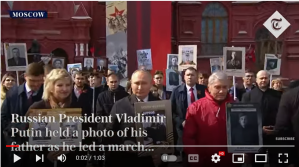 [Image, 5/9/22, Russia Victory Parade, Putin holds photo of his father, UK Telegraph video]
[Image, 5/9/22, Russia Victory Parade, Putin holds photo of his father, UK Telegraph video]
In fact the Ukraine started the war on Wednesday, February 16 2022, when its forces near the Donbas republics began preparatory artillery strikes for an all out ground attack on the Donbas republics.
The February 15 report of the OSCE Special Monitoring Mission to Ukraine recorded some 41 explosions in the ceasefire areas. This increased to 76 explosions on Feb 16, 316 on Feb 17, 654 on Feb 18, 1413 on Feb 19, a total of 2026 of Feb 20 and 21 and 1484 on Feb 22.
The OSCE mission reports showed that the great majority of impact explosions of the artillery were on the separatist side of the ceasefire line.

bigger...On February 19 the Ukrainian President Zelensky announced at the Munich Security Conference that the
Ukraine would ditch the Budapest memorandum and all related agreements. The Budapest memorandum is about Ukraine committing to be a non-nuclear state.
Those two issues, an imminent ground attack on Donbas and the Ukraine threatening to strive for nuclear weapons, drove the Russian decision on February 21 to recognize the Donbas republics as independent states.
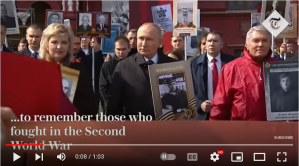 [Image: 5/9/22, Russia Victory Day Parade, holding photos of those who fought in WWII, UK Telegraph video]
[Image: 5/9/22, Russia Victory Day Parade, holding photos of those who fought in WWII, UK Telegraph video]
(The legal precedence for doing such is the ‘western’ recognition
of Kosovo as an independent state.)
Common defense agreements between the independent states and the Russian Federation were signed. Three days later,
during which the Ukrainian attacks on the Donbas republics continued,
Russian troops entered the Ukraine under Article 51
of the U.S. [also UN] charter.—
Over the last days there were some interesting developments of the ground.
1. North of Karkov Russian troops are pulling back to shorten their frontline. The city will have to wait until the Donbas has been regained. The Ukraine again declares it is winning as it retakes the towns the Russians have earlier left.

bigger...2. After heavy fighting Russian forces broke through the eastern Donbas front and conquered the heavily defended city of Popasna.
MilitaryLand.net @Militarylandnet – 8:30 UTC · May 8, 2022
Ukrainian forces withdrew from Popasna to more favorable and fortified positions in the vicinity, the head of #Luhansk Oblast confirms #UkraineRussiaWar
The city is on a hill about 260 meters above sea level. This is about 100+ meters higher than the areas north, south and west of it. Artillery stationed on the hill will have a very good view and can reach deep into Ukrainian held grounds. It will be able to interdict resupplies on nearby roads to the Ukrainian front troops.
The Ukrainian army process of withdrawing to ever ‘more favorable and fortified positions’ will probably end in Lviv.
3. The Ukrainian military had launched a commando attack on Snake Island (in the semi circle 30 miles south of Odessa).

bigger..However after previous Ukrainian air attacks, Russian troops had already left the island
and the Russian airforce had laid an ambush for the attack forces. The Russian Defense Ministry briefings mentioned Ukrainian losses around Snake (Zmeinyi) Island and related operations several times.
“The following have been shot down in the air near Zmeinyi [Snake] Island: 1 Ukrainian Su-24 bomber, 1 Su-27 fighter jet, 3 Mi-8 helicopters with paratroopers and 2 Bayraktar-TB2 UAV. The Ukrainian amphibious assault boat Stanislav has also been destroyed.”
“A Ukrainian naval corvette of project 1241 has also been destroyed near Odessa. ...
During the night, Russian air defence means destroyed 2 more Ukrainian Su-24 bombers and 1 Mi-24 helicopter of the Ukrainian Air Force over Snake Island, and also shot down 1 Bayraktar-TB2 unmanned aerial vehicle near Odessa.
A total of 4 Ukrainian aircraft, 4 helicopters, including 3 with paratroopers on board, 3 Bayraktar-TB2 UAV and 1 Ukrainian Navy amphibious assault boat have been destroyed in the area during the day.”
“Russian air defence means have shot down 1 Bayraktar-TB2 unmanned aerial vehicles near Zmeinyi Island.”
“Oniks high-precision missiles launched by Bastion coastal missile system near Artsiz, Odessa region, have destroyed Ukrainian helicopters at a bounce platform [“a helicopter supply pad that is not a full airport”].. …
Three Ukrainian unmanned aerial vehicles, including two Bayraktar-TB2, have been hit over Snake Island.”
(Bounce platform is a mistranslation for a helicopter supply pad that is not a full airport.
The operation was quite costly for the Ukrainian side. Besides the 60+ paratroopers who were killed during the assault one of the helicopter also had the deputy commander of the Ukrainian navy on board. Today it was announced that Col. Ihor Bedzai was killed in action when his helicopter came under Russian airforce fire.
More than 4 helicopters, 4 jets and 6 Bayraktar drones
were lost for zero gain.
The U.S. is in the process of giving the Ukraine a total of 16 Mi-17 transport helicopters that were originally supposed to go to Afghanistan. At the current Ukrainian rate of losses such supplies, just like others, will not last for long.
Under the current circumstances Snake Island is of little military value. It seems that the sole point of the Ukrainian operation to retake it was to create a propaganda item for today’s Victory Parade.
It now is one
but for the Russian side.
Update 17:15 UTC:
The last briefing (09.05.2022 (19:15) by the Russian Defense Ministry (published after the above post) again mentions Snake Island:
“According to the updated information, 6 Mi-8 and Mi-24 helicopters have been destroyed during the night near Artsiz in Odessa Region near the Chervonoglinskoe military airfield by Onyks high-precision missiles from the Bastion coastal missile system….
On 7 May, on direct orders from Zelensky, the Ukrainian General Staff,
with the direct involvement of advisers from
planned a major provocation to seize Zmeiny [Snake] Island.
Over the past two days, the Kiev regime has made several desperate attempts
to land air and sea assaults on Zmeiny Island,
which is important for controlling the northwestern part of the Black Sea.
The Ukrainian provocation was thwarted as a result of the competent actions of a Russian Armed Forces unit on the island. The enemy [ie, the US] suffered heavy losses.
4 Ukrainian airplanes, including 3 Su-24 and 1 Su-27, 3 Mi-8 helicopters with paratroopers on board, and 1 Mi-24 helicopter
have been shot down in the air
while repelling the attacks near Zmeiny Island.
Within two days, 29 Ukrainian UAVs have been shot down in the air, including 8 Bayraktar TB-2 strike UAVs. Meanwhile, 4 Bayraktar drones have been shot down this afternoon.
Also, 3 armoured Ukrainian amphibious assault boats carrying Ukrainian naval personnel were destroyed during an attempted landing on the night of May 8.
As a result of Zelensky’s thoughtless provocation, more than 50 Ukrainian saboteurs have been killed at sea and on the coast during the landing and attempts to consolidate on the island.
24 bodies of dead Ukrainian servicemen were left on the shore of Zmeiny [Snake] Island.”
…………………
Posted by b on May 9, 2022 at 16:20 UTC | Permalink
*****************
Added: Map of Ukraine and surrounding area
************************
Added: Source and background of 1942 Hemingway quote above:
9/22/1994, “Hemingway, the American left, and the Soviet Union: some forgotten episodes.” freelibrary.com, Cary Nelson
1942:
“Anyone who loves freedom owes such a debt to the Red Army that it can never be repaid:”…
“In fact the statement appeared in Russian on page four of the
23 February 1942, issue of Pravda. An English translation follows:
“Twenty-four years of discipline and labor have created an eternal glory, the name of which is the Red Army.
Anyone who loves freedom owes such a debt to the Red Army that it can never be repaid.”…
1941, from a Hemingway letter:
““I am with the soviet Union one hundred percent in their war of resistance against Nazi aggression. The people of the soviet union are fighting and dying for the defence of all people who oppose the enslavement of fascism….I salute the Soviet Union for their heroic resistance.”…
“As for his [Hemingway’s] general support for the Left, several further gestures need to be placed in the record. The first is confirmed in another unpublished letter. In the summer of 1941 Hemingway was in regular correspondence with Rolfe as part of their combined effort to help Alfred Kantorowicz, a German Communist and veteran of the Loyalist side in the Spanish Civil War, who had been detained in France and was now working to take up residence in the United States. Hemingway sent Rolfe some money for Kantorowicz (Kanto). But other events were also intruding on that summer. On 22 June Germany invaded the Soviet Union. A few weeks later, on 12 July, a British-Soviet mutual assistance treaty was signed. Rolfe, who was living in New York and had begun working at TASS, the Soviet News Agency, the year before, apparently wrote to Hemingway to request a statement in support of the pact for TASS to distribute.(4) Hemingway wrote back to Rolfe offering a more general statement of support for the Soviet Union; here is a transcription of his letter, with the idiosyncracies of Hemingway’s typing style preserved:
FINCA VIGIA SAN FRANCISCO DE PAULA CUBA
Dear Ed:
Thanks for looking after the Kanto dough etc. Hope I didn’t sound rude or sore when wrote. Was simply in a hurry and spooked Kanto would maybe lose that dough through some sort of regulation that they might be ignorant of. Glad they had as much out of that other as they did.
About the statement telegram; You know how I am about statements. I gag on them like someone with an impedimens of speech trying to get a word out.
They usually start with I and sound so god-awful pompous and it seems to presumptious for the writer to be even commenting if he is doing nothing.
However if they want a statement at your office to send to Russia here is as clear a one as I can make.
“I am with the soviet Union one hundred percent in their war of resistance against Nazi aggression. The people of the soviet union are fighting and dying for the defence of all people who oppose the enslavement of fascism. The war in China has shown that no people who know what they are fighting for can be conquered if they all fight and if their country is large enough so that the invader is cut off from his base and surrounded as he advances. I salute the Soviet Union for their heroic resistance.”
If that isn’t clear enough can amplify it.
For me to comment on the British pact is no good. I think the British made Hitler, kept the French from destroying him when he marched into Rhineland encouraged and armed him to fight Russia and to hail a pact with them now as anything more than a temporary thing which they will denounce at any time that suits them is something I could not do.
Copy the other statement out though, Eddy and tell them they can send it if it is of any use. I would much rather be there doing anything I could against the Nazis.
Best always
Ernest(5)
Like many other people strongly committed to Spain, Hemingway found it difficult to trust the British. their disingenuous policy of nonintervention in Spain had been difficult enough to tolerate;
the appeasement of Hitler at Munich in 1938 had confirmed his doubts.”…
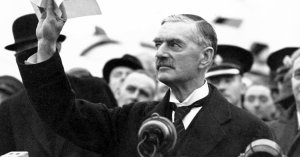 [Image: 1938, UK’s Neville Chamberlain waves letter from Hitler promising not to invade UK: “Hitler agreed to meet in Munich with Chamberlain, Italian leader Benito Mussolini and French premier Edouard Daladier to discuss a diplomatic resolution to the crisis….Chamberlain also separately drafted a non-aggression pact between Britain and Germany that Hitler signed.…Summoned to Buckingham Palace to give a first-hand report to King George VI, Chamberlain was cheered on by thousands who lined the five-mile route
from the airport. As the rain poured, thousands flooded the plaza in
front of the royal residence. As if it were a coronation or a royal
wedding, the frenzied cheers brought forth the king and queen along with Chamberlain and his wife onto the palace balcony. In an unprecedented move, the smiling king motioned the prime minister to step forward and receive the crowd’s adulation as he receded into the background to leave the stage solely to a commoner.
[Image: 1938, UK’s Neville Chamberlain waves letter from Hitler promising not to invade UK: “Hitler agreed to meet in Munich with Chamberlain, Italian leader Benito Mussolini and French premier Edouard Daladier to discuss a diplomatic resolution to the crisis….Chamberlain also separately drafted a non-aggression pact between Britain and Germany that Hitler signed.…Summoned to Buckingham Palace to give a first-hand report to King George VI, Chamberlain was cheered on by thousands who lined the five-mile route
from the airport. As the rain poured, thousands flooded the plaza in
front of the royal residence. As if it were a coronation or a royal
wedding, the frenzied cheers brought forth the king and queen along with Chamberlain and his wife onto the palace balcony. In an unprecedented move, the smiling king motioned the prime minister to step forward and receive the crowd’s adulation as he receded into the background to leave the stage solely to a commoner.
After his royal audience, Chamberlain returned to his official residence at No. 10 Downing Street. There a jubilant crowd shouted “Good old Neville!” and sang “For He’s a Jolly Good Fellow.” From a second-floor window, Chamberlain addressed the crowd and invoked Prime Minister Benjamin Disraeli’s famous statement upon returning home from the Berlin Congress of 1878, “My good friends, this is the second time in our history that there has come back from Germany to Downing Street peace with honor.
I believe it is peace for our time.”
Then he added, “Now I recommend you to go home and sleep quietly in your beds.”...Eight months later, Chamberlain was forced to resign,
and he was replaced by Winston Churchill.”]
(continuing): “Their [UK] long-standing resentment over the Russian withdrawal from the First World War was well known. Thus Hemingway makes a political distinction–the sort his biographers sometimes consider him incapable of making–and thereby finds it possible to offer a significant public gesture, one made six months before the Japanese attack on Pearl Harbor and the United States’ entrance into the war. And this he sends to Rolfe to give to his employers at TASS, the Soviet News Agency, despite purportedly having “said farewell to the Comintern in For Whom the Bell Tolls.” Hemingway, it should be noted, had refused a similar request from Rolfe a year earlier during the Soviet invasion of Finland, but now the issues seemed clear, and he acted accordingly. A slightly revised version of Hemingway’s statement was issued shortly in translation in the Russian-language edition of the Moscow-based journal International Literature. It appears on page 194 of issue No. 7-8 (1941), the sixth statement in a series titled “Cultural Masters on Hitler’s Villainous Assault on the USSR.” Hemingway’s contribution follows statements from Theodore Dreiser, Upton Sinclair, Heinrich Mann, H.G. Wells, and Hewlett Johnson. It is preceded by a one-sentence introduction: “The famous writer Ernest Hemingway, who is now in Cuba, sent the following statement to a TASS correspondent.” Statements by eight additional people, including Kantorowicz, round out the article. Hemingway’s statement, long forgotten in the U.S., was published and now for the first time we know the name of the TASS correspondent (Rolfe) to whom Hemingway wrote and possess the original English language version of his statement. The published version, translated into Russian, omits Hemingway’s third sentence (about China) and makes a few other changes.(6)
Notably, this was neither Hemingway’s first, nor his last comment written expressly for publication in the USSR. The first, of course, was his now famous April 1938 statement in Pravda about the Spanish Civil War, the manuscript of which was discovered in the Hemingway archives at the Kennedy Library by William Watson.
Hemingway wrote briefly for Pravda again in 1942. He wrote to Rolfe in February of that year to say “They [TASS] asked me for a statement for publication in the press of the Soviet Union for February 23 and I sent it off, I think in plenty of time, by cable. Do let me know if it was received.”
In fact the statement appeared in Russian on page four of the
23 February 1942, issue of Pravda. An English translation follows:
“Twenty-four years of discipline and labor have created an eternal glory, the name of which is the Red Army.
Anyone who loves freedom owes such a debt to the Red Army that it can never be repaid.
But we can declare that the Soviet Union will receive the arms, money, and provisions it needs. Anyone who fulminates against Hitler should consider the Red Army a heroic model which must be imitated.”
Hemingway’s statement is the fourth in a series of five, the first three being by the Canadian Minister of Aviation (Mr. Power), Cuban President Batista, and the Czechoslovak Military and Aviation Attache (Colonel Spaniel) in the U.S. Hemingway’s contribution
is followed by one from the Commander of U.S. forces in the Far East,
The overall heading is “The Red Army is the Pride of Peace-Loving Peoples: Foreign Figures Salute the Red Army.” The front page of that issue of Pravda, it should be noted, commemorates the twenty-fourth anniversary of the Red Army and includes a large picture of Stalin.
As one might expect, in the United States much was made of the Red Army’s anniversary by the Communist Party’s newspaper The Daily Worker. The paper gave advance notice of the event and its 24 February 1942 issue published MacArthur’s comments in a news story, “General MacArthur’s Greeting to Red Army on 24th Anniversary” (4). An editorial, “MacArthur Hails the Red Army” (6), reinforced the story’s importance.
Hemingway’s greeting, however, was ignored, receiving no mention whatsoever.
Still an honored name in the Soviet Union, Hemingway was persona non grata to the American party, which had actively joined the condemnation of For Whom the Bell Tolls in 1940. Indeed, two years later, Samuel Putnam’s 1944 Daily Worker article “The Odyssey of Ernest Hemingway” would attack the novel yet again.
Meanwhile, despite these attacks from the Left and despite his own considerable misgivings about Soviet Communism, Hemingway himself remained steadfast.
It was the Russians, after all,
not anyone else,
who were killing German soldiers in significant numbers.
It was partly that awareness that led him to appear in Pravda one more time–with a New Year’s greeting published on page four of the 3 January 1943, issue. Under the heading “New Year’s Greetings to the Soviet Union from Foreign Writers,” Pravda’s back page issues statements by Dreiser, Hemingway, Leon Feuchtwanger, and Thomas Mann. Hemingway’s statement may be translated as follows:
“In 1942 you saved the world from the forces of barbarity,
offering resistance alone,
almost without help.”…
These three contributions to Soviet publications–in 1941, 1942, and 1943–-suggest that if Hemingway said farewell to the Comintern in 1940, as Kenneth Lynn claims, it was a very long goodbye indeed.(7) In fact Hemingway stayed in contact with Communists he met in Spain still longer than that; his last letter to Rolfe was written in 1953, the year before Rolfe died. For too long, evaluations of Hemingway’s politics have been dominated by the cold war ideologies of a number of his biographers. That has led to ignoring friendships Hemingway chose to maintain and even to ignorance about several of his political statements. It is time we assess his politics in the light of all his relevant actions. We need to ask what cultural forces led Hemingway to believe and act as he did and to consider both as potentially reasonable, not to assume that conformity to our beliefs would have been his only reasonable course.
There was nothing extraordinary, certainly, about Hemingway being a fellow traveller in the 1930s, nothing extraordinary about his supporting the Soviet Union during the Second World War. Hemingway’s repeated willingness–from 1938 to 1942–to write statements expressly for publication in the Soviet Union is another matter, as is his repeated eagerness to give financial support to Communist veterans of the Spanish Civil War. The first shows a willingness to cooperate with institutionalized Communism that many American writers would not have shared; the second shows a depth of personal commitment to that most passionate of all 1930s Left-wing causes–the defense of the Spanish Republic–that puts Hemingway in a special status amongst his peers. Finally, his public decisions to stand by his Spanish comrades at the outset and well into the McCarthy period–in 1947 and again in 1953, as documented in Remembering Spain–shows a steadfastness and courage on Hemingway’s part that has not always been acknowledged. All this required continued contact with the international Left and more sustained commitment than Hemingway’s recent biographers have been willing to admit.
Instead, we have sometimes been subjected to judgments filtered through a cold war anti-Communism that had no place in Hemingway’s world.”…
NOTES
(1.)The argument that Hemingway was duped by an international Communist conspiracy finds its most recent expression in Stephen Koch’s highly speculative Double Lives (1994). This scenario does not survive reflection about Hemingway’s actual experience in Spain and the large number of ordinary men and women from many countries he met there.
(2.)See Cary Nelson, ed. Remembering Spain, which is accompanied by a cassette recording of Hemingway reading and commenting on “On the American Dead in Spain.”
(3.)See Nelson and Hendricks, eds. Edwin Rolfe for photographic reproductions of this and one other previously unpublished Hemingway letter to Rolfe. A third unpublished Hemingway letter is included in Remembering Spain.
(4.)So far as I can determine, Rolfe’s letter to Hemingway has not survived. Part of its content, however, can be inferred from Hemingway’s response.
(5.)Hemingway’s letter to Rolfe is in the Edwin Rolfe Archive in the Rare Books and Special Collections Library at the University of Illinois at Urbana-Champaign. Although it is undated, the letter’s approximate date–July 1941–is apparent from the events referred to and from its place in a sequence of letters about Kantorowicz. The date on Hemingway’s envelope is unreadable.
(6.)Hemingway’s statement, published in Russian, may be translated as follows. Italicized passages represent changes made either by Tass or by Pravda editors; passages in brackets are Hemingway’s original words as sent to Rolfe: “I am with the Soviet Union one hundred percent in their military [war of] resistance against fascist [Nazi] aggression. The people of the Soviet Union, through their struggle, defend [are fighting and dying for the defense of! all people who oppose the enslavement of fascism. I proudly salute the Soviet Union for their heroic resistance.”
(7.)Hemingway’s 1938 essay on the Spanish Civil War in Pravda, his 1941 statement in International Literature, and his 1943 greeting in Pravda–but not his 1942 publication about the Red Army in Pravda–are all listed in the useful Russian-language bibliography Ernest Kheminguei: Biobibliograficheskii ukazatel. It was compiled by I. M. Levidova and B. M. Parchevskaia at the All-Union State Library for Foreign Literature and is part of a series of books on writers from foreign countries. Hemingway’s 1942 statement, it should be noted, was reprinted in the Russian-language journal Soviet Culture in May of 1965. I was led to the original 1942 publication by Hemingway’s 23 February 1942 letter to Rolfe, which is in the Edwin Rolfe Archive at the University of Illinois. Translations of passages in Russian were provided to me by Emilio Millan, a graduate student at the University of Illinois, for which I express my considerable appreciation.
It is worth noting that Hemingway’s four Soviet publications are not listed in Hanneman (1967) or Hanneman (1975), although the Levidova bibliography listing three of them was published in 1970. American Hemingway scholars might thus have rediscovered these publications twenty years ago.
WORKS CITED
Baker, Carlos. Hemingway: A Life Story. New York: Scribner’s, 1969.
Hanneman, Audre. Ernest Hemingway: A Comprehensive Bibliography. Princeton, NJ: Princeton UP, 1967.
_____. Supplement to Ernest Hemingway: A Comprehensive Bibliography. Princeton, NJ: Princeton UP, 1975.
Hemingway, Ernest. [Statement]. In “Mastera kul’tury o razboinom napadenii Gitlera na SSSR” (“Cultural Masters on Hitler’s Villainous Attack on the USSR”). International Literature No. 7-8 (1941), 194.
_____. [Statement]. In “Krasnaia Armiia–gordost’ svobodoliubivykh narodov: Inostrannye deiteli privetstvuiut Krasnuiu Armiiu” (“The Red Army is the Pride of Peace-Loving Peoples: Foreign Figures Salute the Red Army”). Pravda. 23 February 1942, 4.
_____. [Statement]. In “Novogodnie privetstviia inostrannykh pisatelei Sovetskomu Soiuzu” (“New Year’s Greetings to the Soviet Union from Foreign Writers”). Pravda, 3 January 1943, 4.
Koch, Stephen. Double Lives: Spies and Writers in the Secret Soviet War of Ideas Against the West. New York: Free Press, 1994.
Levidova, I. M. and B. M. Parchevskaia. Ernest Kheminguei: Biobibliograficheskii ukazatel’. (Ernest Hemingway: A Biobibliographical Index). Moscow: Kniga, 1970.
Lynn, Kenneth S. Hemingway. New York: Simon and Schuster, 1987.
Mellow, James R. Hemingway: A Life Without Consequences. Boston: Houghton Mifflin, 1992.
Meyers, Jeffrey. Hemingway: A Biography. New York: Harper & Row, 1985.
Nelson, Cary, ed., Remembering Spain: Hemingway’s Civil War Eulogy and the Veterans of the Abraham Lincoln Brigade. Urbana: U of Illinois P, 1994.
Nelson, Cary and Jefferson Hendricks, eds. Edwin Rolfe: A Biographical Essay and Guide to the Rolfe Archive at the University of Illinois at Urbana-Champaign. Urbana: U of Illinois, 1990.
Putnam, Samuel. “The Odyssey of Ernest Hemingway,” The Daily Worker (Sunday Magazine), 29 October 1944, 20.”

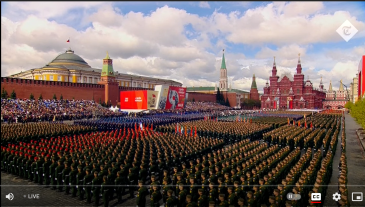

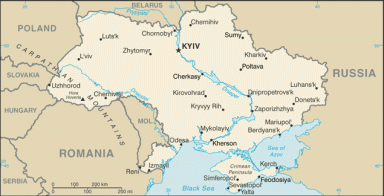
No comments:
Post a Comment